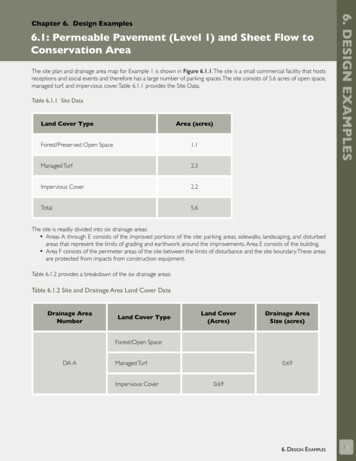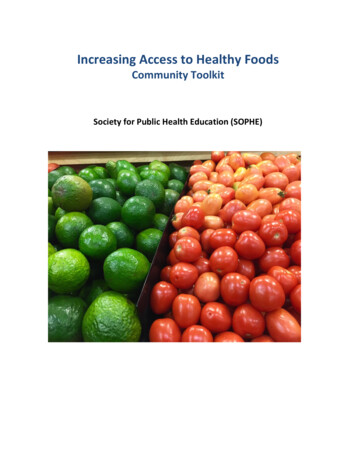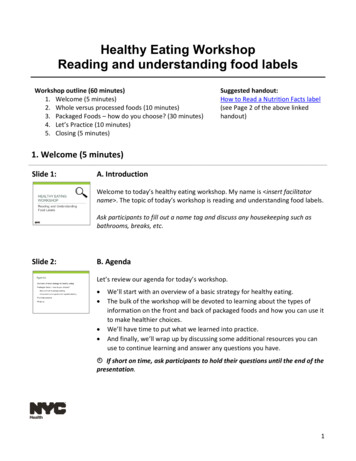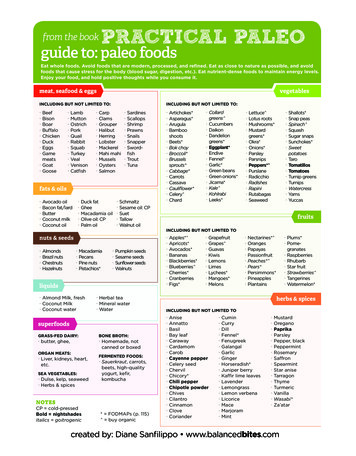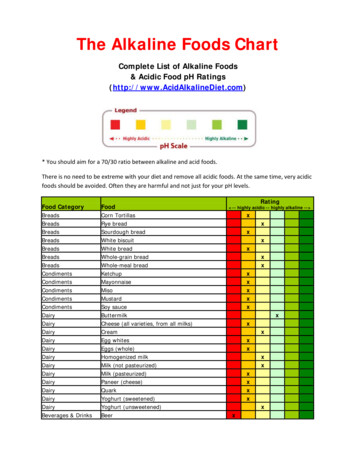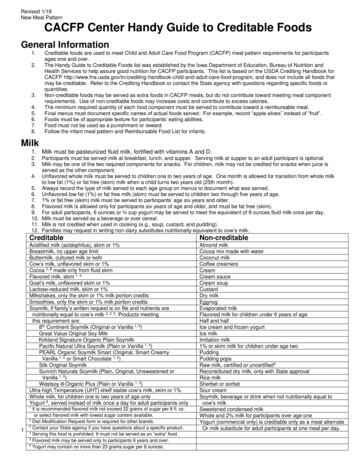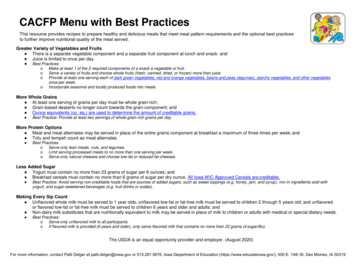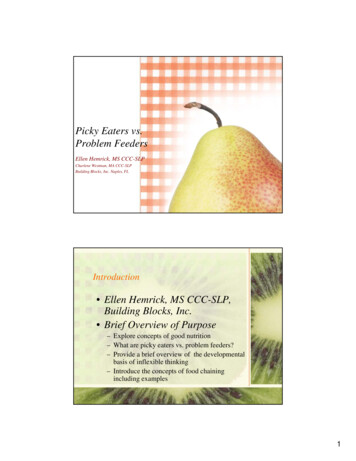
Transcription
Crediting Foods inCACFP
AcknowledgmentsIn accordance with Federal civil rights law and U.S.Department of Agriculture (USDA) civil rights regulations and policies, the USDA, its Agencies, offices,and employees, and institutions participating in oradministering USDA programs are prohibited fromdiscriminating based on race, color, national origin,sex, disability, age, or reprisal or retaliation forprior civil rights activity in any program oractivity conducted or funded by USDA. Personswith disabilities who require alternative means ofcommunication for program information (e.g. Braille,large print, audiotape, American Sign Language, etc.),should contact the Agency (State or local) wherethey applied for benefits. Individuals who are deaf,hard of hearing or have speech disabilities maycontact USDA through the Federal Relay Serviceat (800) 877-8339. Additionally, programinformation may be made available in languagesother than English. To file a program complaintof discrimination, complete the USDA ProgramDiscrimination Complaint Form, (AD-3027) foundonline at: http://www.ascr.usda.gov/complaintfiling cust.html, and at any USDA office, or write aletter addressed to USDA and provide in the letter allof the information requested in the form. To requesta copy of the complaint form, call (866) 632-9992.Submit your completed form or letter to USDA by:(1) mail: U.S. Department of AgricultureOffice of the Assistant Secretary for Civil Rights1400 Independence Avenue, SWWashington, D.C. 20250-9410;(2) fax: (202) 690-7442; or(3) email: program.intake@usda.gov.This institution is an equal opportunity provider.
Table of ContentsPurpose of this Guide.2Eat Well Play Hard.3Meal Pattern Requirements and Recommendations.4Child Nutrition (CN) Label at Alternates .31Infant Foods.39Water.47Appendix A: Sample Menus.49Appendix B: Recipe Analysis.50Appendix C: Meat Alternates for Vegetarian Menu Planning.51Appendix D: Choking Prevention.52Appendix E: Milk Substitutes.53Appendix F: How to Identify Whole Grains.54Index .55New York State Department of Health1
Purpose of this GuideCrediting Foods in CACFP is a guide to help youdetermine if a food counts toward the Child andAdult Care Food Program (CACFP) Meal Patternrequirements.Creditable foods are those that may be countedtoward meeting the requirements for a reimbursablemeal. Foods are creditable based on the following: nutrient content function of the food in a meal CACFP Meal Pattern requirements Food and Drug Administration and United StatesDepartment of Agriculture standards and policydecisionsNon-creditable foods are those that do not counttoward the meal pattern requirements. However,these foods may supply additional nutrients and addcolor, taste and texture to meals.A meal is reimbursable only if it contains creditablefoods for each required component in the amountsoutlined in the CACFP Meal Patterns.This guide has a section for each meal patterncomponent: milk vegetables/fruits grains/bread meat/meat alternatesTo help you make the healthiest choices for thechildren in your care, each food component list hasthree sections: Recommended – These are healthy food choicesthat meet CACFP Meal Pattern requirements.Serve these foods often. Not Recommended but Allowed – These are lesshealthy food choices that meet CACFP MealPattern requirements. Serve these foods onlyoccasionally. Not Allowed – These foods do not count towardCACFP Meal Pattern requirements.This guide does not include every food thatmay be served. For further information, check theUnited States Department of Agriculture's Food BuyingGuide for Child Nutrition Programs. It is available at thefollowing website: hild-nutrition-programs.This guide will help you decide how much food to prepareto meet CACFP Meal Pattern requirements.If you have any further questions, please call1-800-942-3858 or visit www.health.ny.gov/CACFP.Each section has answers to commonly askedquestions and a list of foods that are counted oroften questioned for that component.2Crediting Foods in CACFP
Eat Well Play HardCACFP encourages New York State child careprograms to get children and adults to Eat Well andPlay Hard by adopting these five strategies. As a childcare provider, you are a vital resource in reversingthese statistics. From the foods and beverages youchoose to serve, to the amount of time you allot forphysical activity, you have a tremendous influenceon the health and well-being of children in care.1. Increase physical activityappropriate for their age Provide opportunities for children to engage indaily active play. Children should play at least60 minutes per day. Encourage caregivers and parents to bephysically active with childrenMealtime Environment for ChildrenAn important part of promoting the health ofchildren is providing healthy food served in apleasant, enjoyable environment. Follow these tipsto promote good eating habits in children. Serve food family style, with children servingthemselves from common bowls and pitchers. Have adults sit with children and eat the samefood that the children are eating. Let children decide how much and what foodsthey wish to eat. Encourage, but do not force, children to trynew foods. F ocus on each other and the food you are alleating. Keep the TV turned off.Eat Well Play HardCACFP is concerned with the health of New YorkState children because: T he most common nutrition concern ischildhood obesity. I n New York State, 29% of low-incomepreschoolers and 34% of school-age childrenare overweight or obese. Children who remainoverweight through their teens are more likelyto be overweight as adults.2. Decrease screen time Turn off the TV, video tapes, DVDs andscreen games, tablets and phones No screen time for children under 2 years No screen time during meals and snacks3. Increase fat-free (skim) or low-fat (1%)dairy foodsfor children 2 years of age and older Offer fat-free (skim) or low-fat (1%) milk Select reduced-fat or part-skim cheeses Use low-fat dairy foods in cooking4. Increase the number of vegetablesand fruits served Choose vegetables or fruits for snacks Limit fruit juice to one serving per day Offer a variety of vegetables and fruits Provide fresh vegetables and fruits often Serve vegetables or fruits for breakfast Serve at least one vegetable at lunch and supper5. Increase the initiation and duration ofexclusive breastfeedingBecome a Breastfeeding-Friendly Child Care Centeror Breastfeeding-Friendly Day Care Home. ContactCACFP for information or visit our website atwww.health.ny.gov/CACFP. O verweight adults are at higher risk for diabetes,heart disease and other medical problems.New York State Department of Health3
Meal Pattern Requirements and RecommendationsFood GroupMilkREQUIREMENTSRECOMMENDATIONS Children 1-year-old: unflavored whole milk. Serve only unflavored milk to all participants. C hildren 2-18 years and adults: unflavoredlow-fat (1%) or unflavored fat-free(skim) milk. I f flavored milk is served to children 6 yearsand older, or adults, check the Nutrition FactsLabel to limit sugar to 22 grams or less per cup(8 ounces). F lavored milk served to children 6 years andolder and adults must be fat-free. T he menu must specify the type of milk served(i.e., whole, low-fat or 1%, and fat-free orskim) and if it is flavored.Vegetables/Fruits One vegetable and one fruit, or two differentvegetables must be served at lunch andsupper to children 1-year-old and olderand adults. Juice is limited to one serving per day forchildren 1-year-old and older and adults. Only 100% juice may be offered. Juice must not be served to infants beforeage 1. W hen developmentally ready, a vegetable orfruit, or both, must be served at meals andsnack for infants 6 months of age to theirfirst birthday.4 Serve a variety of vegetables and fruits. Serve vegetables and fruits as snacks. E ach week, provide at least one serving of darkgreen, red and orange vegetables. O ne or more servings of vegetables/fruits perday should be high in Vitamin C. T hree or more servings of vegetables/fruits perweek should be high in Vitamin A. T hree or more servings of vegetables/fruits perweek should be fresh.Crediting Foods in CACFP
Meal Pattern Requirements and RecommendationsFood GroupGrains/BreadREQUIREMENTSRECOMMENDATIONS A t least one serving of grains per day must bewhole grain-rich. Provide at least two servings of whole grainsper day. B reakfast cereals cannot contain more than6 grams of sugar per ounce. A ll breads and cereals served should bewhole grain. G rain-based desserts no longer count towardthe grain component. B reakfast cereals may be served as a grain atsnack for infants 6 months of age to their firstbirthday.Meat/Meat Alternates Meat and meat alternates may be served inplace of the grains component at breakfast amaximum of three times per week. Tofu can be served as a meat alternate. Y ogurt can be plain, flavored, sweetened orunsweetened. Y ogurt cannot contain more than 23 grams ofsugar per 6 ounces. For infants 6 months of age to their firstbirthday, cheese, cottage cheese, yogurt, andwhole eggs are allowable meat alternates. Serve only lean meats, nuts, and legumes. M eat/meat alternates should be preparedwithout added fat. L imit serving processed meats (e.g., hot dogs,corn dogs, chicken nuggets, fried chicken,fish sticks, Vienna sausages, or deli meat)to no more than one serving per week. S erve only natural cheeses and choose low-fator reduced-fat varieties. C heese foods and cheese spreads arenot allowed.Other Drinking water must be offered to childrenthroughout the day and made available uponrequest. S upport mothers who choose to breastfeedtheir infants. Encourage mothers to supplybreast milk for their infants while in day care. Water is not counted as a component. O ffer a quiet, private area that is comfortableand sanitary for mothers who come to thecenter or day care home to breastfeed. Food and beverage must not be used as apunishment or reward. Frying food on-site is not allowed. I ncorporate seasonal and locallyproduced foods. Limit purchase of pre-fried foods to no morethan once per week. A void serving non-creditable foods that aresources of added sugars, such as sweettoppings (e.g., honey, jam, syrup), mix-iningredients sold with yogurt (e.g., honey,candy, or cookie pieces), and sugar sweetenedbeverages (e.g., fruit drinks or sodas).New York State Department of Health5
Child Nutrition (CN) LabelThis voluntary federal labeling program for theChild Nutrition Programs allows manufacturers tostate on the food label how the product contributesto meal pattern requirements. Products eligible forCN labels include commercially-prepared foods thatcontribute significantly to one or more mealcomponents. If served in the amount stated onthe label, all CN-labeled foods are creditable.How to identify a CN LabelA CN label will always contain the following: the CN logo which is a distinct border USDA/FNS authorization the month and year of approval the serving size required to meet mealpattern requirements.CN000000*This 5.00 oz. Pizza with Ground Beefand Vegetable Protein Product provides2.00 oz. equivalent meat/meat alternates,1/2 cup serving of vegetable and 1 1/2CN servings of bread alternate for the Child CNNutrition Meal Pattern Requirements.(Use of this logo and statementauthorized by the Food and NutritionService, USDA, 00/98**)CNFor a detailed explanation on CN Labeling, seethe Food and Nutrition Service (FNS) website:www.fns.usda.gov/cnd/cnlabeling.6Crediting Foods in CACFP
MilkMilk RequirementsTo be creditable, milk must be pasteurized and meetstate and local standards for fluid milk. All milkshould contain Vitamin A and Vitamin D at levelsspecified in FDA regulation 21 CFR 131.110. Milk isan excellent source of calcium, phosphorus, protein,Vitamin A and Vitamin D.Milk is not creditable when used in the preparationof products such as hot cereals, soups, puddings orother foods.If a child cannot consume fluid milk, parents orguardians may request, in writing, milk substitutes.The written request must identify the medical orother special dietary need that restricts the child’sdiet. Milk substitutes must be nutritionallyequivalent to milk and meet the nutritionalstandards for fortification of calcium, protein,Vitamin A, Vitamin D and other nutrientsto levels found in cow’s milk.At breakfast or snack, fluid milk canbe served as a beverage, on cereal or both.At lunch and supper, fluid milk mustbe served as a beverage.At snack, if fluid milk is served, juicecannot be counted as the other component.Two beverages cannot be served at one snack.Child Meal Pattern Requirements Fluid milk must be served for breakfast, lunchand supper. One-year-olds must be served whole milk. Children 2-18 years must be served fat-free(skim) or low-fat (1%) milk. Unflavored milk must be served to children 1-5years. If flavored milk is served to children 6 years oldand older, it must be fat-free (skim) milk. The menu must specify the type of milk servedand if it is flavored.New York State Department of HealthAdult Meal Pattern Requirements Fat-free (skim) or low-fat (1%) milk must beserved at least once per day at meal or snack.Six ounces (or ¾ cup) of yogurt may be servedin place of one cup of milk at other meals. Atsupper, neither milk nor yogurt are required. Yogurt cannot contain more than 23 grams ofsugar per 6 ounces. Unflavored milk is recommended. If flavoredmilk is served, it must be fat-free. The menu must specify the type of milk servedand if it is flavored.7
MilkQuestions and Answers about MilkQ: Can milk used in puddings, saucesand soups count toward the milkrequirement? o. Milk used in the preparation of foods isA: Nnot creditable.Q: If a child cannot have milk, may I servesoy milk instead?Yes, soy milk may be served to children or adultsA: with medical or special dietary needs as long as itis nutritionally comparable to milk. Milk substitutesmust meet the standards listed in Appendix E,but they are not required to be low-fat or fat-freewhen served to children 2 years old andolder and adults. Parents or guardians mustrequest milk substitutes in writing (no medicalstatement is needed). However, a medicalstatement is required for milk substitutesthat do not meet the nutrition standardsoutlined in Appendix E. Lactose-reducedmilk does not require a written request fromparents or guardians.Q: Can milk be purchased directly froma farm?Q: Can smoothies be offered to meet themilk components? es. Milk used in smoothies may be creditedA: Ytoward the milk requirement when preparedby program operators. If yogurt is used, itmay be credited as a meat alternate (not as asubstitute for milk). If vegetables and fruits areused, they are credited as juice. Please notethat juice is limited to one serving per day forchildren 1-year-old and older and adults.Q: What type of milk must be used whenmaking smoothies? he type of milk used must be consistent with theA: Tage group being served.Q: How do store bought smoothies counttoward meal pattern requirements?Store bought smoothies may only be credited asA: juice toward the vegetable or fruit component.They cannot count toward the milk componentbecause it is impossible to determine the amountof milk used.Yes, as long as it is pasteurized fluid milk,A: which meets state and local health standards.Also, it must include vitamin A and vitamin Dlevels consistent with state and local standards.Q: Can flavored milk be served? es, but only fat-free (skim) flavored milk canA: Ybe served to adults and children 6 years andolder. If served, it is recommended that flavoredmilk contain 22 grams of sugar or less per cup(8 ounces).Q: Why is dry milk mixed with waternot creditable?USDA only allows use of dry milk in emergencyA: situations when the center is unable to obtaina supply of fluid milk on a continuing basis(7 CFR 226.20(f)).8Crediting Foods in CACFP
MilkRECOMMENDED AS MILKFood ItemCommentsAcidified MilkFor adults and children 2 years old and older, must be fat-free (skim) or low-fat (1%).Acidified milk is made by souring fluid milk with an acidifying agent. Examples: acidified kefirmilk and acidified acidophilus milk.Buttermilk, culturedFor adults and children 2 years old and older, must be fat-free (skim) or low-fat (1%).Must be cultured and meet state and local standards. See: Cultured Milk.Cultured MilkFor adults and children 2 years old and older, must be fat-free (skim) or low-fat (1%).Cultured milk is produced by adding selected micro-organisms to fluid milk under controlledconditions to produce a product with specific flavor and/or consistency. Examples: culturedbuttermilk, cultured kefir milk and cultured acidophilus milk.Fat-free Milk(Non-fat, Skim)Not creditable for children less than 2 years of age. See: Milk, fluid.Lactose-reduced Milk,Lactose-free MilkChildren or adults who cannot digest the lactose in milk may benefit from lactose-reduced orlactose-free milk. See: Milk, fluid.Low-fat Milk (1%)Not creditable for children under 2 years of age. See: Milk, fluid.Milk SubstitutesMilk Substitutes must be nutritionally equivalent to milk and meet the nutritionalstandards for fortification of calcium, protein, Vitamin A, Vitamin D and other nutrientsto levels found in cow’s milk. Parents or guardians must request milk substitutes in writing.Milk, fluid(unflavored)Type of milk required: 12 to 24 months old: Whole 2 years old and older: Fat-free (skim) or low-fat (1%)Rice MilkSee: Milk Substitutes.Smoothie, homemadeMilk may be credited toward the milk requirement. The type of milk used must be consistentwith the age group being served. Vegetables and fruits may be credited as juice. Yogurt maybe credited as a meat alternate. Grains cannot be credited. Store bought smoothies may onlycredit as juice toward the vegetable and fruit components.Soybean or Soy MilkSee: Milk Substitutes.Ultra High Temperature(UHT) MilkUHT is Grade A pasteurized milk that has been heated to about 280 F. See: Milk, fluid.Whole MilkRequired for children 12 to 24 months old. Not creditable for adults and children 2 years oldor older. See: Milk, fluid.New York State Department of Health9
MilkNOT RECOMMENDED BUT ALLOWED AS MILKThe foods listed below are creditable for adults and children 6 years old and olderbut are not recommended. These foods are high in added sugar.Food Item10CommentsChocolate Milk or Cocoa MilkSee: Flavored Milk.Eggnog-flavored MilkSee: Flavored Milk.Flavored MilkCreditable for adults and children 6 years or older. Must be made with fat-free (skim)milk. Limit due to the high sugar content. As a best practice, it is recommended thatflavored milk contain 22 grams of sugar or less per cup (8 ounces).Hot Chocolate/Hot CocoaSee: Flavored Milk.Crediting Foods in CACFP
MilkNOT ALLOWED AS MILKThe foods listed below are not creditable.These foods do not count toward the CACFP Meal Pattern requirements.Certified Raw MilkCheese – allowed as a meat alternateCoconut MilkCreamCream SauceCream SoupCustardEvaporated MilkFrozen YogurtGoat’s Milk –medical exception onlyHalf and HalfIce Cream/Ice MilkImitation MilkNon-fat Dry Milk, reconstituted – allowed in emergencies only with USDA approvalPudding PopsPuddingReduced-fat Milk (2%) – medical exception onlySherbetSour CreamYogurt - allowed as a meat alternate; may be counted as milk for adults onlyNew York State Department of Health11
12Crediting Foods in CACFP
Vegetables/FruitsVegetables and Fruits RequirementsThe CACFP Meal Pattern requires vegetables and/orfruits to be served for breakfast, lunch and supper.Vegetables and fruits may also be served ascomponents for snack. The combined vegetableand fruit component has been separated into twogroups for lunch, supper and snack. Refer to theCACFP Meal Pattern for serving size requirements. Breakfast must include a serving of vegetableor fruit or both. L unch and supper must include a serving ofa vegetable and fruit OR two servings ofdifferent vegetables. A t snack, two different components must beserved. Offering a vegetable and fruit counts astwo different components. However, offeringtwo different items from the same componentdoes not count as a reimbursable snack. Forexample, sliced apples and celery sticks wouldcount as a reimbursable snack, but orange juiceand apple slices would not. B eans may be counted as a vegetable or a meatalternate. However, one serving of dried peas orbeans cannot be counted as a vegetable and ameat alternate in the same meal. T he minimum creditable amount for vegetablesand fruits is 1/8 cup. Small amounts (less than1/8 cup) used as garnishes or in soups, stews,sandwiches and salads may not be counted tomeet the vegetable or fruit requirement. O nly one serving of 100% juice may be servedper day to children 1-year-old and older andadults. Beverages that have Vitamin C added andstate 100% Vitamin C on the label may or maynot be 100% juice. A snack cannot consist of only two beverages(Example: juice and milk). H ome-canned products are not allowed becauseof food safety concerns.New York State Department of HealthVegetables and Fruits RecommendationsVegetables and fruits are excellent sources of vitamins,minerals and fiber. CACFP recommends that: Vegetables and fruits should be fresh, frozen orcanned and prepared with no added sugar, saltor fat. Vegetables and fruits are served at snack. At least one serving of dark green, red andorange vegetables are served each week. One or more servings of vegetables/fruits perday should be high in Vitamin C. Three or more servings of vegetables/fruits perweek should be high in Vitamin A. Three or more servings of vegetables/fruits perweek should be fresh. Local and seasonal vegetables/fruits are offeredwhenever possible.Adding vegetables and fruits to meals is anexcellent way to enhance flavors, add color andoffer opportunities to try new foods. While smallamounts (less than 1/8 cup) of vegetables and fruitsare not creditable toward meeting meal patternrequirements, CACFP encourages you to includevarious vegetables and fruits whenever possible: Chopped onion, celery or carrots in soups, stewsor casseroles Pureed pumpkin mixed with yogurt Sliced tomato in grilled cheese sandwiches Lettuce on sandwiches Lemon juice on fish or salads13
Vegetables/Fruits Brussels Sprouts Cabbage CarrotsCauliflower Grapefruit/grapefruit juice Chard Dandelion Greens Mustard Greens Spinach Turnip Greens Mixed VegetablesOkra NectarinesOranges/orange juice Plums Prunes Raspberries Strawberries Tangerines Parsnips Peas and Carrots Peas, green Peppers Potatoes, sweet Potatoes, white Pumpkin Squash, winter Tomatoes/tomato juice Turnips Vegetable Juice 14 Beet GreensKale Dried Fruits(apple, apricots,dates, figs, peaches,prunes or raisins)Dark, leafy on Vitamin A FoodsVitamin CAsparagusFoodsCalciumFRUITSIronVEGETABLESVitamin A V ITAMIN C – serve at least one of these foodsevery day CALCIUM – serve these foods daily IRON – serve these foods oftenVitamin CVegetables and Fruits High in Important NutrientsVegetables and fruits are excellent sources of vitamins,minerals and fiber. CACFP recommends that: VITAMIN A – serve at least one of these foodsthree times a week Crediting Foods in CACFP
Vegetables/FruitsQuestions and Answers about Vegetablesand FruitsQ: If one serving of mixed vegetables isoffered at lunch, does it meet the mealpattern requirement for serving twovegetables?A: No. Mixed vegetables, fruit cocktail and similarcombinations only count as one vegetable or fruit.Q: Does the sauce on pizza count asa vegetable?A: No. There is not enough sauce on a serving ofpizza to count as a vegetable.Q: How are vegetables, fruits and otherfoods counted in mixed dishes such asbeef stew or chili?vegetable and fruit meal pattern requirement.Other ingredients such as mayonnaise, pasta ornuts cannot be counted in the serving size.Q: Are dried vegetables and fruitscreditable?A: Yes. The serving size for dried vegetables andfruits is half that of fresh or canned. For example,if a 1/2 cup of fruit is required, 1/4 cup of raisinsmay be served. Please be aware that dried fruitsmight pose a choking hazard to young children(See: Appendix D).Q: How do leafy greens count toward thevegetable component?A: One cup of leafy greens (i.e., lettuce, raw spinach,etc.) counts as ½ cup of vegetables.A: Mixed dishes vary greatly on how they maybe credited. Up to three food components canbe counted if the recipe includes enough ofeach ingredient to be considered as a serving.For example, a serving of beef stew for a3-5-year-old needs to include at least 1 ½ ouncesof meat and a ¼ cup vegetables. For canned or frozen beef stew, the label will nottell you how much meat, carrots or potatoes arein each serving. Therefore, the stew would notmeet the vegetable or meat components unlessthe item has a Child Nutrition (CN) label.Q: Can canned pumpkin be added totomato sauce and be counted towardthe vegetable component?A: Yes, pureed vegetables and fruits may contributetoward meal pattern requirements as long as thedish also provides an adequate amount (1/8 cup)of recognizable, creditable vegetables and fruits. Inthis example, canned pumpkin could be countedtoward the vegetable component because tomatosauce is recognizable.Q: Are foods like coleslaw or potato saladcreditable?A: Yes, but only the actual amounts of the vegetableand fruit ingredients can be counted toward theNew York State Department of Health15
Vegetables/FruitsRECOMMENDED AS VEGETABLES/FRUITSFood ItemCommentsApple CiderMust be pasteurized. No more than one serving of juice may be served per day.Applesauce, unsweetenedBeans, canned or dryExamples include: black beans, black-eyed peas, cannellini beans, garbanzo beans,kidney beans, lentils, navy beans, northern beans, pigeon beans, pinto beans, soy beansor split peas. A serving of beans may count as a vegetable or as a meat alternate,not both.BerriesExamples include: blackberries, blueberries, raspberries or strawberries.ColeslawCranberry Juice BlendCranberry juice in a blend with another 100% juice is creditable. Cranberry JuiceCocktail is not creditable. No more than one serving of juice may be served per day.Frozen Fruit Juice BarsMust be 100% fruit and/or fruit juice.Fruit, canned in 100% juiceor waterFruit, driedExamples include: apricots, cranberries, dates, figs, prunes or raisins. The serving sizefor dried fruit is half that of fresh or canned. Example: for a 1/2 cup vegetables/fruitsrequirement, 1/4 cup of raisins may be served. Not recommended for children under fouryears old due to the risk of choking.Fruit, freshExamples include: apples, apricots, bananas, berries (all types), clementines, grapes,grapefruit, guava, kiwi, kumquats, mangos, melons (all types), oranges, papayas, passionfruit, peaches, pears, persimmons, pineapples, plantains, pomegranates, plums, star fruitor tangerines. Three or more servings of fresh fruits are recommended per w
In New York State, 29% of low-income preschoolers and 34% of school-age children are overweight or obese. Children who remain overweight through their teens are more likely to be overweight as adults. Overweight adults are at higher risk for diabetes, heart disease and other medical problems. CA
